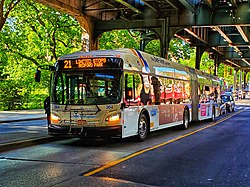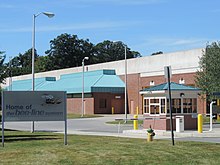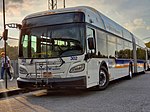Bee-Line Bus System
 | |
 New Flyer XDE60 #364 operates on Route 21 limited stops towards Bedford Park. | |
| Parent | Westchester County Department of Public Works and Transportation |
|---|---|
| Founded | May 1, 1978 |
| Headquarters | 100 East First Street, 9th Floor Mount Vernon, NY 10550 |
| Locale | Westchester County, New York |
| Service area | Westchester County, New York and Putnam County, New York; The Bronx and Manhattan in New York City; and Fairfield County in Connecticut |
| Service type | Local, Limited, express,shuttle buses |
| Routes | 64 |
| Fleet | 327 fixed route 91 paratransit |
| Daily ridership | 111,316 (2013) [1] |
| Fuel type | Diesel, Diesel-electric hybrid |
| Operator |
|
| Chief executive | Hugh J. Greechan, Jr., P.E., Commissioner |
| Website | Bee-Line Bus System |
The Westchester County Bee-Line System, branded on the buses in lowercase as the bee-line system, is a bus system serving Westchester County, New York. The system is owned by the county's Department of Public Works and Transportation.
History
[edit]The system was founded on May 1, 1978, by the then Westchester County Department of Transportation to consolidate the bus system with thirteen private bus companies and has been given control over the buses, fare structure, routes, and services. By the 1980s, the bus system had an identity problem in who was providing the service. On May 19, 1987, WCDOT officially named the bus service "The Bee-Line System" with a 'bee-in-flight' mascot drawn by cartoonist Jack Davis.[2][3]
The Westchester County Department of Public Works and Transportation currently contracts out to two private bus companies to provide service in Westchester County and the surrounding counties: Yonkers-based Liberty Lines Transit, Inc., the main company that either bought out or obtained franchises from the other twelve bus companies over the years, operates buses on all but three bus routes; and Cortlandt Manor-based P.T.L.A. Enterprise, Inc., a small company that operates buses on routes 16, 18, and 31.
Scope of service
[edit]
Most Bee-Line routes operate seven days a week. There is no service county-wide on two days of the calendar year, Thanksgiving (the fourth Thursday in November), and Christmas (December 25).
Within Westchester
[edit]The system's 64 routes are mostly concentrated in the more urban southern portion of the county, with the cities of Mount Vernon, New Rochelle, and Yonkers receiving a high frequency of service. White Plains, the county seat and most centrally located city, is a major transportation hub with many routes converging on the city's TransCenter.
Service in the northern portion of Westchester is sparse and is concentrated near slightly populated areas such as Mount Kisco, Ossining, or Peekskill. Areas such as Lewisboro, North Salem, and Pound Ridge receive paratransit service only. During the school year, special bus routes also operate. All but the county's smallest, most rural communities have at least rush hour service.[4]
Outside Westchester
[edit]Because Westchester County borders on the New York City borough of the Bronx, many of the Bee-Line's routes operate into the Bronx, offering Westchester residents connections to MTA New York City Transit buses and subways; at least one Bee-Line route connects to each subway route serving the Bronx. The Bee-Line System also operates an express route, the BxM4C from White Plains, Greenburgh, Hartsdale, Scarsdale, and Yonkers along Central Park Avenue to Fifth Avenue in Manhattan (return trips operate on Madison Avenue within Manhattan).
Bee-Line operates mostly closed-door service in the Bronx (local service is not provided solely for travel within the Bronx; appropriate MTA Regional Bus Operations service must be used instead). The only exceptions are:
- Routes 40, 41, 42 and 43, which run along White Plains Road north of the Wakefield – 241st Street subway terminal;
- Route 45, which serves the Pelham Bay Park subway terminal, the Pelham Bay and Split Rock Golf Course, and the Bartow-Pell Mansion;
- Route 54, which runs on Mundy Lane along the Bronx/Mount Vernon border, since no other bus routes travel entirely through these areas;
- Routes 60 and 61, which run along US Route 1 (East Fordham and Boston roads in the Bronx).
In addition, Route 12 briefly enters Greenwich, Connecticut along King Street, in which it makes stops in Greenwich and Rye Brook, New York along the New York/Connecticut border; Route 16 briefly enters Putnam County to serve the Mahopac Village Centre; and Route 77 enters Putnam County to serve the US Route 6 corridor between Mahopac and Carmel.[4]
Fares
[edit]All fares require exact change or MetroCard. All transfers are free with payment of fare. Dollar bills are not accepted on any Bee-Line System buses.[5]
| Route | Full fare | Senior/ disabled fare |
Transfer All transfers good for 2 hours |
7-day unlimited ride MetroCard | 30-day unlimited ride MetroCard |
|---|---|---|---|---|---|
| All except BxM4C | $2.75 | $1.35 |
|
$33.00 $16.50 with Reduced Fare ID |
$127.00 $63.50 with Reduced Fare ID |
| BxM4C | $7.50 | $3.75 (Off peak only) |
|
No Unlimited-Ride MetroCards accepted | |
Notes:
| |||||
Bee-Line Bus started accepting MetroCard on April 1, 2007.[6] The fare for the BxM4C went down from $7 to $5. The regular fare was $2 for MetroCard, and $1.75 if paid in cash. Dollar bills, passports, and ticket books were no longer accepted for fare payment after this date.[7] MetroCard Vans made stops on heavily used routes to help people get ready for the MetroCard.[8] On July 23, 2019, it was announced that the Bee-Line bus fare system on all buses would be upgraded to the OMNY fare system in 2021–2022, replacing the MetroCard. The Westchester County Department of Transportation states that "OMNY is targeted for introduction on the Bee-Line Bus System beginning in 2022 at the earliest." OMNY hasn't been installed as of 2023, but is expected to be installed in late 2023 to early 2024. MetroCard will continue to be accepted by New York City Transit subways and buses and Bee-Line service until 2024, enabling Bee-Line passengers to have the option of using MetroCard or OMNY during the transition phase. By 2024, MetroCard will be discontinued and all Bee-Line passengers will then use OMNY. The Reduced-Fare MetroCard Program will also be converted over to OMNY."[9]
For certain periods during the summer and winter of 2022, the buses were fare-free.[10] As of the summer of 2023, buses are fare free until Labor Day 2023.
Fleet
[edit]Active fleet
[edit]This roster only lists buses and shuttle vans used in fixed route service. Paratransit vehicles are not listed. All buses are wheelchair accessible.
| Fleet numbers | Year | Photo | Manufacturer | Model | Length | Width | Notes |
|---|---|---|---|---|---|---|---|
| 116–136 | 2005 | 
|
Orion Bus Industries | Orion V 05.505 | 32 ft (9.8 m) | 96 in (2.4 m) | |
| 801–830
(30 total) |
2008 | 
|
Orion Bus Industries | Orion V 05.501 | 40 ft (12 m) | 102 in (2.6 m) |
|
| 205–299
(95 total) |
2009 | 
|
North American Bus Industries | NABI 40-LFW HEV | |||
| 301–378
(78 total) |
2018–2020 | 
|
New Flyer Industries | Xcelsior XDE60 articulated | 60 ft (18 m) |
| |
| 100–110 (6 delivered) | 2023–2024 | New Flyer Industries | Xcelsior XDE35 | 35 ft (11 m) | |||
| 141–144
(4 total) |
2021–2022 | New Flyer Industries | Xcelsior XE35 | 35 ft (11 m) |
| ||
| 145–146
(2 total) |
2021 | New Flyer Industries | Xcelsior XE40 | 40 ft (12 m) | |||
| 398–503
(106 total) |
2021–2022 | New Flyer Industries | Xcelsior XDE40 | ||||
| 504–515 (11 delivered)
516-555? (future deliveries; numbers unknown) |
2023–2024 | 
|
New Flyer Industries | Xcelsior XDE40 |
|
Past fleet
[edit]| Year | Builder and model name |
Length (feet) |
Width (inches) |
Numbers | Year Last Retired | Notes | |
|---|---|---|---|---|---|---|---|
| 1978 | General Motors Corporation RTS-03 TH-7603 |
35 | 96 | 101–106, 189–190, 194–205 |
1996 |
| |
| 1978 | General Motors Corporation RTS-03 TH-8603 |
40 | 96 | 107–188, 191–193 |
1996 |
| |
| 1983 | MAN SG-310-16.5-2A (articulated) |
60 | 102 | 600–661 | 2002 |
| |
| 1986– 1987 |
Motor Coach Industries 102A2 |
40 | 102 | 901–936 | 2009 |
| |
| 1990 | Flxible Metro-B 40102-6T |
40 | 102 | 760–874 | 2007 |
| |
| 1990 | Flxible Metro-B 40102-6C |
40 | 102 | 875–879 | 2001 | ||
| 1994 | Startrans Supreme Senator |
25 | 96 | 301–310 | 1999 |
| |
| 1994 | Orion Bus Industries 02.501 |
25.92 | 96 | 311 | 2000 |
| |
| 1995 | Advanced Vehicle Systems AVS22 |
22 | 102 | 312 | Unknown |
| |
| 1995– 1996 |
Orion Bus Industries 05.501 |
40 | 102 | 401–484 | 2009 |
| |
| 1997 | Startrans Supreme Senator |
25 | 96 | 313–332 | 2004 |
| |
| 1999 | Startrans Supreme Senator |
25 | 96 | 333–361 | 2005 |
| |
| 2000–2003 | Neoplan USA AN460 "Transliner" articulated |
60 | 102 | 501–578 | 2020 |
| |
| 2002 | DaimlerChrysler Orion 05.505 |
32 | 96 | 101–115 | 2012 |
| |
| 2005 | Coach and Equipment Phoenix |
25 | 91 | 301–318 | 2010 |
| |
| 2006 | Orion Bus Industries
07.501 (hev) |
40 | 102 | 201–204 | 2022 |
| |
| 2006 | Orion Bus
Industries 05.501 |
40 | 102 | 601–704 | 2023 |
| |
| 2007 | Coach and Equipment Phoenix |
25 | 91 | 319–320 | 2010 |
|
Future fleet
[edit]In February 2020, it was announced that Westchester County's Bee-Line Bus fleet would be expanding with 78 hybrid-electric 60-foot buses (all delivered by summer 2020), 106 hybrid-electric 40-foot buses and two 40-foot battery-electric buses – all built by New Flyer Industries – under a plan to have the entire transit bus fleet running on either fully electric or diesel-electric hybrid technology by 2025. As of July 2020, 106 40-foot diesel-electric buses and two 40-foot battery-electric are planned to be delivered between 2021 and 2025. Four 35-foot battery-electric buses are also planned to be delivered, totaling 6 battery-electric buses by 2025.[15][16][17]
References
[edit]- ^ "National Transit Database Program Filing for The Bee-Line System, 2013" (PDF). Archived from the original (PDF) on March 4, 2016. Retrieved August 8, 2015. (139 KB)
- ^ "Variable Fares for Elderly & Handicapped Transit Riders: An Analysis of Westchester County" (PDF). (1.25 MB)
- ^ Kriss, Gary (May 24, 1987). "Bus System Gets a Name And a Logo". The New York Times. Retrieved July 7, 2021.
- ^ a b "Bee-Line System Map" (PDF). transportation.westchestergov.com. 2011. Archived from the original (PDF) on October 18, 2015. Retrieved January 1, 2012. (4.64 MB)
- ^ Fares and MetroCard
- ^ "MTA NYC Transit MetroCard – Westchester Bee-Line Buses". mta.info. April 2007. Archived from the original on May 28, 2007. Retrieved May 15, 2017.
{{cite web}}: CS1 maint: bot: original URL status unknown (link) - ^ "All About MetroCard in Westchester". westchestergov.com. April 2007. Archived from the original on August 31, 2007. Retrieved May 15, 2017.
{{cite web}}: CS1 maint: bot: original URL status unknown (link) - ^ "MetroCard Van Schedule". westchestergov.com. April 2007. Archived from the original on September 1, 2007. Retrieved May 15, 2017.
{{cite web}}: CS1 maint: bot: original URL status unknown (link) - ^ "Omny". transportation.westchestergov.com. Retrieved January 31, 2021.
- ^ "County Executive George Latimer Announces Free Rides on the Bee-Line Bus for the Holiday Season" (Press release). Westchester County. November 16, 2022. Retrieved December 23, 2022.
- ^ Coyne, Matt (August 1, 2016). "Westchester Legislators OK New Bee-Line Buses". lohud.
- ^ Malouff, Dan (July 8, 2019). "DASH Is Running the First non-WMATA Articulated Buses in Washington Area Transit". Greater Greater Washington. Retrieved August 15, 2019.
- ^ a b c "Community Buses Roll Into Maine". MaineDOT. January 24, 2012. Retrieved February 4, 2012.
- ^ "Connecticut Public Transportation Commission" (PDF). (97.9 KB)
- ^ "Westchester Awarded $3M For Hybrid-Electric Buses From New York State". westchestergov.com (Press release). February 4, 2020.
- ^ "Westchester County to Expand Its Electric Vehicle Fleet with $1.5M Grant from the US Department of Transportation". westchestergov.com (Press release). June 5, 2020.
- ^ "Going Green: County Approves Nearly $4.5M Bond For Electric Buses". westchestergov.com (Press release). July 21, 2020.



